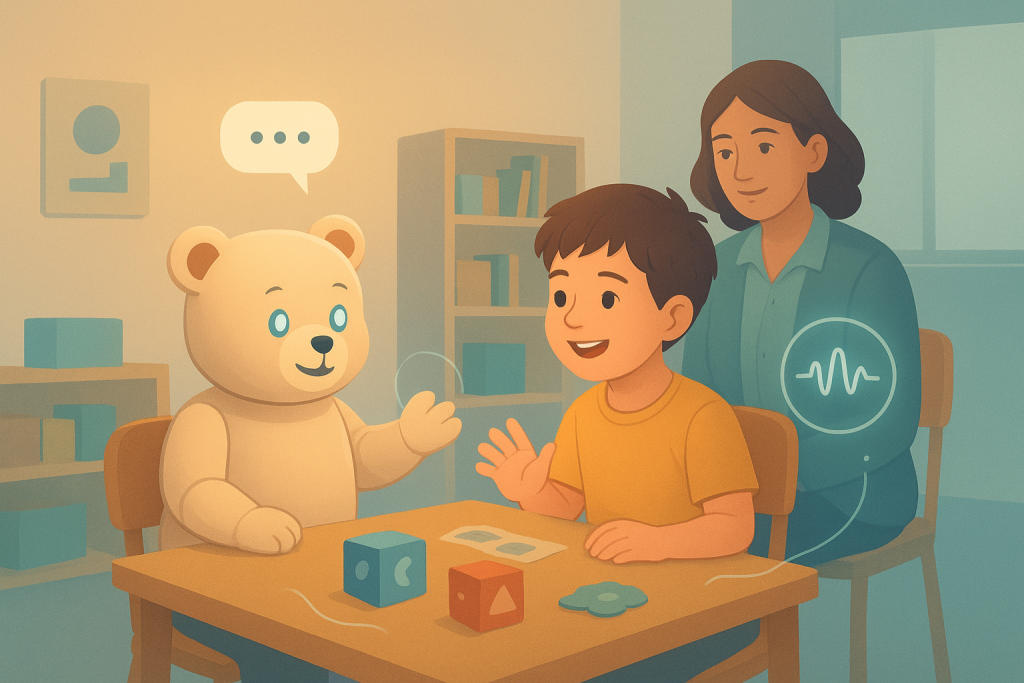
One of the most promising frontiers in AI and special education is the blending of robotics and language models to support social communication. A recent project, Echo-Teddy, is pushing into that space — and it offers lessons, possibilities, and cautions for therapists, educators, and clinicians working with neurodiverse populations.
What Is Echo-Teddy?
Echo-Teddy is a prototype social robot powered by a large language model (LLM), designed specifically to support students with autism spectrum disorder (ASD). The developers built it to provide adaptive, age-appropriate conversational interaction, combined with simple motor or gesture capabilities. Unlike chatbots tied to screens, Echo-Teddy occupies physical space, allowing learners to engage with it as a social companion in real time. The system is built on a modest robotics platform (think Raspberry Pi and basic actuators) and integrates speech, gestures, and conversational prompts in its early form.
In the initial phase, designers worked with expert feedback and developer reflections to refine how the robot interacts: customizing dialogue, adapting responses, and adjusting prompts to align with learner needs. They prioritized ethical design and age-appropriate interactions, emphasizing that the robot must not overstep or replace human relational connection.
Why Echo-Teddy Matters for Practitioners
Echo-Teddy sits at the intersection of three trends many in your field are watching:
- Social skills practice made accessible. Many therapy clients with autism desire more safe, low-stakes opportunities to practice conversational skills, respond to social prompts, or rehearse small social routines. Echo-Teddy offers a discrete, low-pressure companion for repeated practice outside human-delivered sessions.
- Scalable support tool between sessions. Therapists often lament that change happens outside the session. A robot companion can keep the “practice engine” running — offering prompts, models, and conversation opportunities when the therapist isn’t present.
- Bridging human and AI. Because Echo-Teddy is designed with reflexivity (developer feedback loops, expert critique, cautious deployment), it points to how AI + robotics companions may be integrated responsibly. It is not a replacement but an adjunct — a tool to augment therapy and educational strategies.
- Motivation and novelty. Many learners respond positively to novelty or “tech-based” supports. A physical robot that speaks, gestures, and interacts can create enthusiasm and engagement — especially when built to adapt to the student’s pace and cues.
Key Considerations & Challenges
No innovation is without trade-offs. When considering Echo-Teddy’s relevance or future deployment, keep these in mind:
- Relation vs automation: Social communication is deeply human. Robots lack genuine empathy, body awareness, and emotional nuance. The goal is augmentation, not replacement.
- Customization and adaptation: A one-size-fits-all robot won’t work well. Echo-Teddy’s early prototype emphasizes customizability—age, play style, language level, social prompt type—all must be adaptable.
- Ethics, privacy & safety: Conversational data, facial cues, emotional responses—these are sensitive domains. Developers must guard data privacy, informed consent, and clear boundaries around what the robot shouldn’t do.
- Resource access and equity: A robot platform demands hardware, maintenance, and infrastructure. In lower-resource settings, cost and technical support may limit uptake.
- Long-term validation: The field needs longitudinal studies to see if a companion robot actually improves social communication outcomes, maintenance, generalization to human settings, and transfer beyond the robot context.
What You Can Do Today (Pilot Ideas)
- Sandbox trials with older learners: Try a simplified “robot conversation partner” model (even via app or simpler hardware) with clients who are already comfortable with tech, to gauge tolerance, engagement, and how therapy might integrate robot interaction.
- Hybrid sessions: Use a human-led social skills session, then have the student converse with the robot for practice, then debrief what was difficult or surprising.
- Dialogue design input: Therapists and educators can help shape the conversational scripts, social prompts, scaffolding strategies, and recovery responses (when the robot makes a mistake). Your domain knowledge is vital.
- Feedback to developers: Projects like Echo-Teddy benefit enormously from user feedback—therapists can highlight what works, what’s awkward, and which conversational tracks need better tailoring.
Looking Toward the Future
Echo-Teddy is an early model of what the future may hold: embodied AI companions in classrooms, therapy rooms, and home settings, offering low-stakes interaction, scaffolding, and rehearsal. As hardware becomes more affordable and language models become more capable, these robots may become part of an ecosystem: robots, human therapists, software tools, and digital supports working in tandem.
For your audience, Echo-Teddy is a reminder: the future of social-communication support is not just virtual — it’s embodied. It challenges us to think not only what AI can do, but how to integrate technology into human-centered care. When thoughtfully deployed, these innovations can expand our reach, reinforce learning, and provide clients with more opportunities to practice, experiment, and grow.
